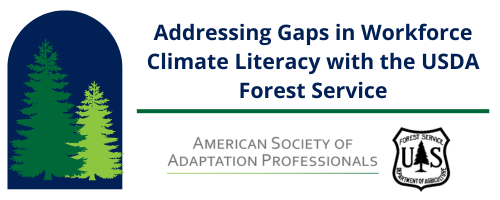Addressing Gaps in Workforce Climate Literacy

ASAP is partnering with USDA Forest Service to create a structured education and training program for Forest Service staff, update ASAP's Knowledge and Competencies Framework, and create a model for improving climate literacy that can be applied in multiple federal agencies and beyond.
Project Activities and Timeline
As of May 2023, we have completed the first year of what we expect to be a three-year project. Over three years, we intend to:
- Analyze the climate literacy needs of key Forest Service staff roles and design holistic training programs to increase the climate literacy of staff in each role.
- Catalog existing education resources and categorize according to the K&C Framework, assess gaps, and develop new content to address gaps.
- Monitor learning outcomes and adapt training programs as needed.
The timetable for each phase of the project is as follows:
Year 1: gathering data, analyzing the learning needs for key roles, and cataloging existing resources
Year 2: building learning programs and developing content to address gaps
Year 3: evaluating and making adjustments to learning programs and training content
Year 1: Use Knowledge and Competencies Framework to analyze the depth of knowledge and level of competency that is required for priority positions within the Forest Service workforce. The analysis will be used to identify specific training needs by staff role.
Years 2 and 3: Review changes to staff positions and correspondingly update list of training criteria.
Year 1: Catalog existing Forest Service climate change education and training resources and reference those resources in the Knowledge and Competency Framework and the training criteria identified. Identify gaps within existing resources to fulfill all training criteria for each position.
Years 2 and 3: Assess the extent to which gaps have been met; identify new gaps.
Year 1: Choose 1-2 priority resources or trainings to augment and address gaps in content. Create plan for out-years to augment additional resources and create new resources as needed.
Years 2 and 3: Create new and plan for additional content.
Year 1: Create training programs for 1-2 positions, including assessments and certificates of completion.
Years 2 and 3: Create additional training programs for other positions.
Years 2 and 3: Monitor learning outcomes, participant experience, and advancements in climate science and climate change strategies. Update the training and education programs to optimize learning outcomes and participant experience while integrating the most up-to-date science and strategies into the content.

Project News and Updates
Let’s Get Educated! Creating a Path to Improving USDA Forest Service’s Climate Literacy
ASAP and USDA Forest Service Partner to Address Gaps in Workforce Climate Literacy
Template Resources Available for Download
As of June 2023, ASAP has produced four template resources as an outgrowth of our first phase of the project. The Methodology for Assessing Workforce Climate Literacy Needs is a document to describe a methodology for addressing climate literacy needs within an organization through analyzing key role types, mapping existing climate literacy resources, assessing gaps, and developing learning program outlines to address gaps for key role types. Explore the four templates:
Role Type Analysis: this document can be used as one of the earliest steps in the users' curriculum development to understand the skills and capacities that individuals serving the priority roles in their organizations need or should have. These skills and competencies are based on ASAP's Knowledge & Competencies Framework.
Climate Change Education Resource Map: this tool is for cataloging information during the climate change project planning process. As a template, it is designed to organize objectives, concepts, including specific elements and the range of resources within a given project. This template encourages thoughtful, multi-dimensional examination of project resources. These skills and competencies are based on ASAP's Knowledge & Competencies Framework.
Gaps Analysis: identifies training and education gaps within teams, as well as potential areas for individual and collective growth. The Gaps Analysis is also used to determine gaps in existing resources (identified by initial role analyses) and the current and programming/educational resource map.
Learning Program Outline: addresses learning and programmatic gaps outlined in the Gaps Analysis. This outline (1) describes the targeted audience; (2) provides a summary of the new or expanded learning objectives for their program; and (3) aligns those objectives with ASAP's Knowledge & Competencies Framework.
Learn more about ASAP's Workforce Program, see our Training and Education for Adaptation and Resilience Professionals, or download ASAP’s Professional Guidance Resources.
